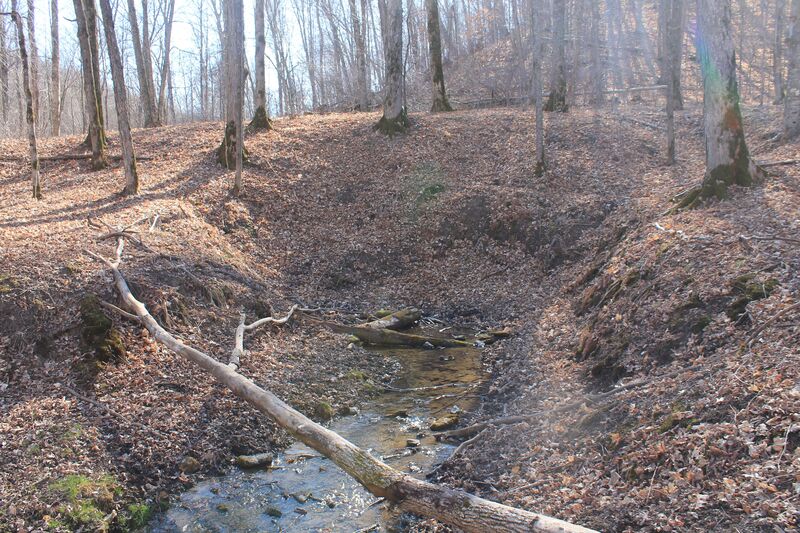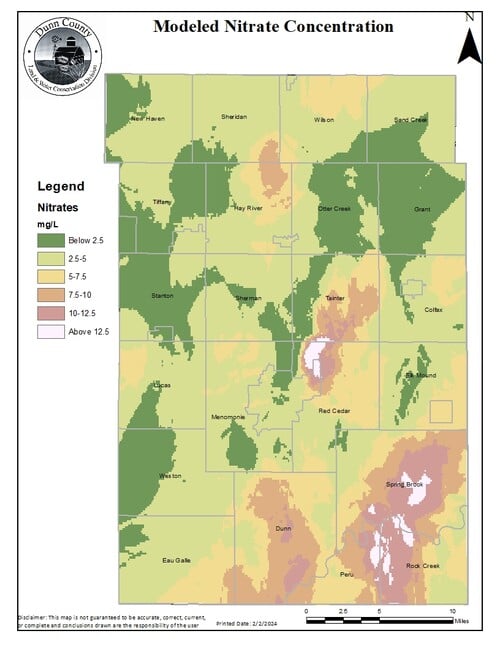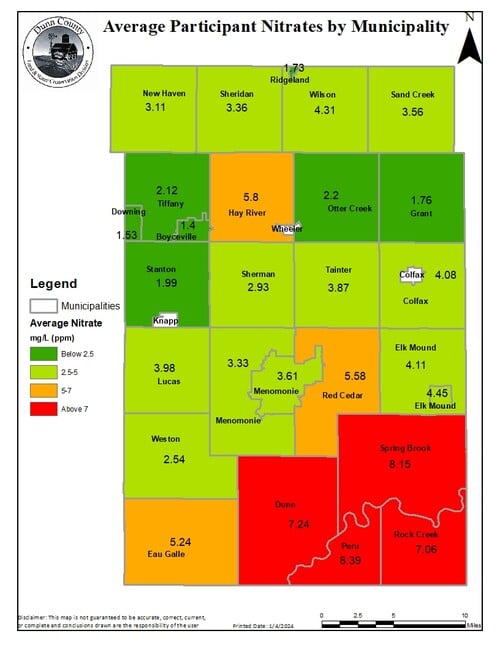
One of the many springs where ground water out flows to form the head waters of Wilson Creek. The current flow is lower than normal due to the extended drought. The lack of snow cover and subsequent snow melt means much of the seasonal recharging of the water table will not occur. Surface waters and shallow wells will have less water this summer.
The 2024 Red Cedar River Watershed Conference went underground with a focus on ground water this year. The first keynote speaker, Kevin Masarik, Groundwater Education Specialist, UW Stevens Point, shared his keynote entitled “Groundwater Quality in the Red Cedar Watershed.” He discussed the efforts, both in the Red Cedar Watershed and statewide to monitor and protect Wisconsin’s ground water. In a breakout session entitled, “A Closer Look at Local Groundwater Monitoring Programs,” Chase Cummings, County Conservationist, and Heather Wood, Water Resources Specialist, from Dunn County, Tyler Gruetzmacher, County Conservationist, from Barron County, and Lynda Schweikert, County Conservationist/Deputy Director, from Chippewa County detailed the many ways each county is working to monitor ground water contamination in their respective counties and to enhance public health.
Mr Masarik explained why ground water is a really big deal in Wisconsin. Ninety-five percent of Wisconsin communities rely on ground water. The other five percent draw their water from the Great Lakes, most notably Lake Michigan. Ground water also provides the base flow that keeps the water flowing year around in our rivers and streams. Put photo and caption in around here When streams like Gilbert and Wilson creeks keep flowing in the middle of the winter, its ground water streaming out of springs that provides the base flow that keeps the water moving. Base flow is also critical for trout streams since emerging ground water is an important component in providing the cold water temperatures that trout need to thrive.
Wisconsin has an abundance of ground water. Deep underground is the bedrock that the ground water sits on. Above that is what Mr Masarik describes as a “layer cake” that may consist of sandstone, dolomite and glacial out wash. This layer cake is where the ground water resides. There is so much ground water under the surface that if it was all pumped to the surface of Wisconsin, the water would form a lake 100 feet deep the size of the entire state.
Ground water is not a static entity under the surface. There are areas where water percolates into the water table and areas where the water out flows into surface water. The water underground flows in various directions. The dynamic nature of ground water keeps the trout streams cold, but also means that if contamination occurs in one area it may end up in the drinking water in another area.
There are many issues with ground water and Mr Masarik went into great detail in describing the major issuers. The most well known and widespread ground water contamination is nitrates.
Dunn County undertook a massive groundwater sampling program last year. The program was run by Heather Wood, the county water resources specialist. Nine hundred and ninety-five private wells were tested in one year. That is a truly amazing accomplishment. The wells were located in all areas of county. The data from the testing provided the county officials with an accurate look at nitrate levels in the county.

As seen in Map 1, the highest nitrate levels on average occur in the southeastern portion of the county, specifically Dunn, Spring Brook, Peru, and Rock Creek townships. Red Cedar, Eau Galle, and Hay River have the next highest average level of nitrates. It must be noted that these are town wide averages, and two adjacent wells may have very different nitrate levels.

Map Two presents the nitrate levels in a location specific map. It displays a more precise representation of nitrate levels in the county. There are two standards for nitrate levels in drinking water the first is the preventative action standard which means a problem is starting to occur and steps should be taken to keep it from getting worse. For nitrates that standard is 2 mg/L. At and over 10 mg/L the water is not deemed safe for drinking, especially for infants, children and pregnant women. Lynda Schweikert reported that Chippewa County recently built a water dispensing station so people can get drinking water for free when their private well water is contaminated by nitrates. Chippewa County is in the planning phase for building more water dispensing stations.
PFAFS (per- and polyfluoroalkyl substances) are another chemical of concern. Wide spread contamination of groundwater by PFAS was discovered in the past 10 years throughout the state. PFAS are very long lasting chemicals. Health risks include decreased fertility or increased high blood pressure in pregnant women, developmental delays in children, increased risk of some cancers, reduced ability of the body’s immune system to fight infections, interference with the body’s natural hormones, and increased cholesterol levels and/or risk of obesity. PFAFS were found in many wells in Dunn County. Fortunately, the levels were well below the levels deemed unsafe for consumption. New standards for safe exposure to PFAFS are being developed, and the levels found in ground water in Dunn County will still be below these new standards.
Water testing is time consuming and expensive. Hence the people testing the water have developed many ways to identify areas of concern so they can focus their limited resources where they will do the most good. Tyler Gruetzmacher displayed a map of Barron County that tracked the frequency of corn cultivation over a 16 year time frame. The areas with the heaviest corn plantings tend to correlate with the nitrate contamination since corn requires large amounts of nitrogen fertilizer. He also noted that one means of lessening nitrate ground water problems is to plant cover crops to keep the unused nitrogen in the top soils. Water testers also look for “markers” that may be indicators of future problems. If the markers are found in ground water, it demonstrates that contaminants have a pathway into that particular well. Chloroform bacteria is one marker. Another interesting marker is artificial sweeteners. Evidently the sweeteners pass through the human body undisturbed, enter the waste stream, and then potentially find their way into the water cycle.
Dunn County will begin another round of private well testing in July. The testing is free. Staff will come to the property to collect the sample and then send it to the lab in Eau Claire for testing. The sample will be tested for nitrates and heavy metals. When the result are completed, the data will be aggregated before public release so individual wells will not be identified in the public data. To sign up for the program, contact Heather Wood at (715) 231-6532, [email protected] or sign up on-line with the qr code.


Add new comment